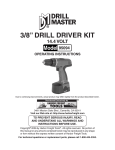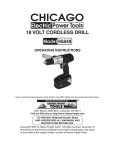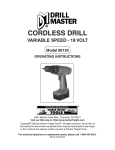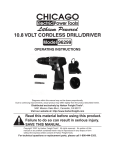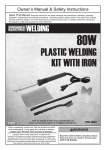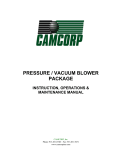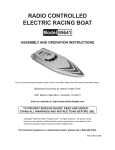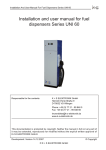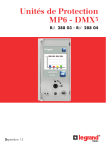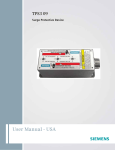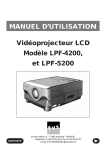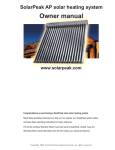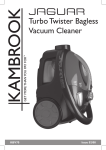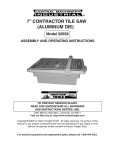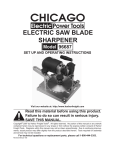Download Harbor Freight Tools 96526 User's Manual
Transcript
19.2V 1/2”CORDLESS DRILL/DRIVER Model 96526 Set-up And Operating Instructions Diagrams within this manual may not be drawn proportionally. Due to continuing improvements, actual product may differ slightly from the product described herein. Distributed exclusively by Harbor Freight Tools®. 3491 Mission Oaks Blvd., Camarillo, CA 93011 Visit our website at: http://www.harborfreight.com Read this material before using this product. Failure to do so can result in serious injury. Save this manual. Copyright© 2007 by Harbor Freight Tools®. All rights reserved. No portion of this manual or any artwork contained herein may be reproduced in any shape or form without the express written consent of Harbor Freight Tools. For technical questions or replacement parts, please call 1-800-444-3353. Save This Manual Keep this manual for the safety warnings and precautions, assembly, operating, inspection, maintenance and cleaning procedures. Write the product’s serial number in the back of the manual near the assembly diagram (or month and year of purchase if product has no number). Keep this manual and the receipt in a safe and dry place for future reference. Important SAFETY Information In this manual, on the labeling, and all other information provided with this product: This is the safety alert symbol. It is used to alert you to potential personal injury hazards. Obey all safety messages that follow this symbol to avoid possible injury or death. Danger DANGER indicates a hazardous situation which, if not avoided, will result in death or serious injury. WARNING WARNING indicates a hazardous situation which, if not avoided, could result in death or serious injury. Caution CAUTION, used with the safety alert symbol, indicates a hazardous situation which, if not avoided, could result in minor or moderate injury. Notice NOTICE is used to address practices not related to personal injury. Caution SKU 96526 CAUTION, without the safety alert symbol, is used to address practices not related to personal injury. For technical questions, please call 1-800-444-3353. Page General Safety Rules WARNING! Read all instructions Failure to follow all instructions listed below may result in electric shock, fire, and/or serious injury. The term “power tool” in all of the warnings listed below refers to your line-operated (corded) power tool or battery-operated (cordless) power tool. SAVE THESE INSTRUCTIONS 1. Work area safety a. Keep work area clean and well lit. Cluttered or dark areas invite accidents. b. Do not operate power tools in explosive atmospheres, such as in the presence of flammable liquids, gases or dust. Power tools create sparks which may ignite the dust or fumes. c. Keep children and bystanders away while operating a power tool. Distractions can cause you to lose control. 2. Electrical safety a. Power tool plugs must match the outlet. Never modify the plug in any way. Do not use any adapter plugs with earthed (grounded) power tools. Unmodified plugs and matching outlets will reduce risk of electric shock. b. Avoid body contact with earthed or grounded surfaces such as pipes, radiators, ranges and refrigerators. There is an increased risk of electric shock if your body is earthed or grounded. c. Do not expose power tools to rain or wet conditions. Water entering a power tool will increase the risk of electric shock. d. Do not abuse the cord. Never use the cord for carrying, pulling or unplugging the power tool. Keep cord away from heat, oil, sharp edges or moving parts. Damaged or entangled cords increase the risk of electric shock. e. When operating a power tool outdoors, use an extension cord suitable for outdoor use. Use of a cord suitable for outdoor use reduces the risk of electric shock. 3. Personal safety a. Stay alert, watch what you are doing and use common sense when operating a power tool. Do not use a power tool while you are tired or under the influence of drugs, alcohol or medication. A moment of inattention while operating power tools may result in serious personal injury. b. SKU 96526 Use safety equipment. Always wear ANSI-approved eye proection. Safety equipment such as dust mask, non-skid safety shoes, hard hat, or hearing protection used for appropriate conditions will reduce personal injuries. For technical questions, please call 1-800-444-3353. Page c. Avoid accidental starting. Ensure the switch is in the off-position before plugging in. Carrying power tools with your finger on the switch or plugging in power tools that have the switch on invites accidents. d. Remove any adjusting key or wrench before turning the power tool on. A wrench or a key left attached to a rotating part of the power tool may result in personal injury. e. Do not overreach. Keep proper footing and balance at all times. This enables better control of the power tool in unexpected situations. f. Dress properly. Do not wear loose clothing or jewelry. Keep your hair, clothing and gloves away from moving parts. Loose clothes, jewelry or long hair can be caught in moving parts. g. If devices are provided for the connection of dust extraction and collection facilities, ensure these are connected and properly used. Use of these devices can reduce dust-related hazards. 4. Power tool use and care a. Do not force the power tool. Use the correct power tool for your application. The correct power tool will do the job better and safer at the rate for which it was designed. b. Do not use the power tool if the switch does not turn it on and off. Any power tool that cannot be controlled with the switch is dangerous and must be repaired. c. Disconnect the plug from the power source and/or the battery pack from the power tool before making any adjustments, changing accessories, or storing power tools. Such preventive safety measures reduce the risk of starting the power tool accidentally. d. Store idle power tools out of the reach of children and do not allow people unfamiliar with the power tool or these instructions to operate the power tool. Power tools are dangerous in the hands of untrained users. e. Maintain power tools. Check for misalignment or binding of moving parts, breakage of parts and any other condition that may affect the power tools operation. If damaged, have the power tool repaired before use. Many accidents are caused by poorly maintained power tools. f. Keep cutting tools sharp and clean. Properly maintained cutting tools with sharp cutting edges are less likely to bind and are easier to control. g. Use the power tool, accessories and tool bits etc., in accordance with these instructions and in the manner intended for the particular type of power tool, taking into account the working conditions and the work to be performed. Use of the power tool for operations different from those intended could result in a hazardous situation. SKU 96526 For technical questions, please call 1-800-444-3353. Page 5. Service a. Have your power tool serviced by a qualified technician using only identical replacement parts. This will ensure that the safety of the power tool is maintained. Specific Safety Rules 1. Maintain labels and nameplates on the tool. These carry important safety information. If unreadable or missing, contact Harbor Freight Tools for a replacement. 2. Avoid unintentional starting. Prepare to begin work before turning on the tool. 3. Do not lay the tool down until it has come to a complete stop. Moving parts can grab the surface and pull the tool out of your control. 4. When using a handheld power tool, maintain a firm grip on the tool with both hands to resist starting torque. 5. Do not leave the tool unattended when it is plugged into an electrical outlet. Turn off the tool, and unplug it from its electrical outlet before leaving. 6. Use clamps (not included) or other practical ways to secure and support the workpiece to a stable platform. Holding the work by hand or against your body is unstable and may lead to loss of control. 7. The battery charger gets hot during use. The charger’s heat can build up to unsafe levels and create a fire hazard if it does not receive adequate ventilation, due to an electrical fault, or if it is used in a hot environment. Do not place the charger on a flammable surface. Do not obstruct any vents on the charger. Especially avoid placing the charger on carpets and rugs; they are not only flammable, but they also obstruct vents under the charger. Place the charger on a stable, solid, nonflammable surface (such as a stable metal workbench or concrete floor) at least 1 foot away from all flammable objects, such as drapes or walls. Keep a fire extinguisher and a smoke detector in the area. Frequently monitor the charger and battery during use. . This product is not a toy. Keep it out of reach of children. 9. People with pacemakers should consult their physician(s) before use. Electromagnetic fields in close proximity to heart pacemaker could cause pacemaker interference or pacemaker failure. In addition, people with pacemakers should: • Avoid operating alone. • Do not use with power switch locked on. • Properly maintain and inspect to avoid electrical shock. SKU 96526 For technical questions, please call 1-800-444-3353. Page • Any power cord must be properly grounded. Ground Fault Circuit Interrupter (GFCI) should also be implemented – it prevents sustained electrical shock. 10. To reduce the risk of personal injury where the drill bit may contact hidden wiring, hold the tool by its plastic insulated gripping surfaces. Contact with a “live” wire will make exposed metal parts of the Cordless Drill/Driver “live” and will shock the operator. 11. Some dust created by power sanding, sawing, grinding, drilling, and other construction activities, contains chemicals known [to the State of California] to cause cancer, birth defects or other reproductive harm. Some examples of these chemicals are: Lead from lead-based paints Crystalline silica from bricks and cement or other masonry products Arsenic and chromium from chemically treated lumber Your risk from these exposures varies, depending on how often you do this type of work. To reduce your exposure to these chemicals: work in a well ventilated area, and work with approved safety equipment, such as those dust masks that are specially designed to filter out microscopic particles. (California Health & Safety Code § 25249.5, et seq.) 12. The warnings, precautions, and instructions discussed in this instruction manual cannot cover all possible conditions and situations that may occur. It must be understood by the operator that common sense and caution are factors which cannot be built into this product, but must be supplied by the operator. Save these instructions. Grounding WARNING Improperly connecting the grounding wire can result in electric shock. Check with a qualified electrician if you are in doubt as to whether the outlet is properly grounded. Do not modify the power cord plug provided with the tool. Never remove the grounding prong from the plug. Do not use the tool if the power cord or plug is damaged. If damaged, have it repaired by a service facility before use. If the plug will not fit the outlet, have a proper outlet installed by a qualified electrician. Grounded Tools: Tools with Three Prong Plugs 1. Tools marked with “Grounding Required” have a three wire cord and three prong grounding plug. The plug must be connected to a properly grounded outlet. If SKU 96526 For technical questions, please call 1-800-444-3353. Page the tool should electrically malfunction or break down, grounding provides a low resistance path to carry electricity away from the user, reducing the risk of electric shock. (See 3-Prong Plug and Outlet.) 2. The grounding prong in the plug is connected through the green wire inside the cord to the grounding system in the tool. The green wire in the cord must be the only wire connected to the tool’s grounding system and must never be attached to an electrically “live” terminal. (See 3-Prong Plug and Outlet.) 3. The tool must be plugged into an appropriate outlet, properly installed and grounded in accordance with all codes and ordinances. The plug and outlet should look like those in the following illustration. (See 3-Prong Plug and Outlet.) 3-Prong Plug and Outlet Outlets for 2-Prong Plug Double Insulated Tools: Tools with Two Prong Plugs 1. Tools marked “Double Insulated” do not require grounding. They have a special double insulation system which satisfies OSHA requirements and complies with the applicable standards of Underwriters Laboratories, Inc., the Canadian Standard Association, and the National Electrical Code. (See Outlets for 2-Prong Plug.) 2. Double insulated tools may be used in either of the 120 volt outlets shown in the preceding illustration. (See Outlets for 2-Prong Plug.) Extension Cords 1. Grounded tools require a three wire extension cord. Double Insulated tools can use either a two or three wire extension cord. 2. As the distance from the supply outlet increases, you must use a heavier gauge extension cord. Using extension cords with inadequately sized wire causes a serious drop in voltage, resulting in loss of power and possible tool damage. (See Table A.) 3. The smaller the gauge number of the wire, the greater the capacity of the cord. For example, a 14 gauge cord can carry a higher current than a 16 gauge cord. (See Table A.) SKU 96526 For technical questions, please call 1-800-444-3353. Page 4. When using more than one extension cord to make up the total length, make sure each cord contains at least the minimum wire size required. (See Table A.) 5. If you are using one extension cord for more than one tool, add the nameplate amperes and use the sum to determine the required minimum cord size. (See Table A.) 6. If you are using an extension cord outdoors, make sure it is marked with the suffix “W-A” (“W” in Canada) to indicate it is acceptable for outdoor use. 7. Make sure the extension cord is properly wired and in good electrical condition. Always replace a damaged extension cord or have it repaired by a qualified electrician before using it. . Protect the extension cords from sharp objects, excessive heat, and damp or wet areas. RECOMMENDED MINIMUM WIRE GAUGE FOR EXTENSION CORDS* (120/240 VOLT) NAMEPLATE AMPERES EXTENSION CORD LENGTH (at full load) 25 Feet 50 Feet 75 Feet 100 Feet 150 Feet 0 – 2.0 18 18 18 18 16 2.1 – 3.4 18 18 18 16 14 3.5 – 5.0 18 18 16 14 12 5.1 – 7.0 18 16 14 12 12 7.1 – 12.0 18 14 12 10 - 12.1 – 16.0 14 12 10 - - 16.1 – 20.0 12 10 - - - TABLE A * Based on limiting the line voltage drop to five volts at 150% of the rated amperes. Symbology Double Insulated Canadian Standards Association Underwriters Laboratories, Inc. SKU 96526 V~ A Volts Alternating Current Amperes No Load Revolutions per Minute n0 xxxx/min. (RPM) For technical questions, please call 1-800-444-3353. Page Specifications Electrical Requirements Drill Speed Charger Input: 120 V~ / 60 Hz Charger Output: 24 VDC / 400mA Battery Type: 1300 mAh Ni-Cd Rechargeable Charge Time: 3 to 5 Hours Power Cord Type: 22 AWG x 2C Dual Speed Drill RPM: 0~400 RPM (#1 Setting) / 0~1050 RPM (#2 Setting) Chuck Type 1/2” Keyless Settings 20 Clutch Settings / 1 Drill Setting Additional Features Reversible Rotation Accessories Battery (Qty. 1) / Charger (Qty. 1) Double Ended Screwdriver Bits (Qty. 2) Drill Dimensions 9-1/2” L x 3-1/8” W x 8-1/8” H (Without Battery) Net Weight 4.2 Pounds Unpacking When unpacking, check to make sure that the item is intact and undamaged. If any parts are missing or broken, please call Harbor Freight Tools at the number shown on the cover of this manual as soon as possible. Set-Up Instructions Read the entire Important Safety Information section at the beginning of this manual including all text under subheadings therein before set up or use of this product. WARNING Risk of accidental starting; resulting in serious personal injury. Turn the Power Switch of the tool to its “OFF” position and unplug the tool from its electrical outlet before assembling or making any adjustments to the tool. Note: For additional information regarding the parts listed in the following pages, refer to the Assembly Diagram near the end of this manual. To Charge The Battery 1. The Battery (29) does not come charged from the manufacturer. Before use, you must charge the Battery. (See Figure A, next page.) 2. Plug the AC/DC Adapter’s (24) 2-prong plug into the nearest 120 volt, grounded, electrical outlet. (See Figure A.) 3. Insert the AC/DC Adapter’s (24) charge cord into the Charger Stand (23). (See Figure A.) SKU 96526 For technical questions, please call 1-800-444-3353. Page 4. Insert the Battery (29) into the Charger Stand (23). (See Figure A.) 5. The Battery (29) will charge in approximately 3 to 5 hours. Do not charge the Battery for longer than 5 hours. Subsequent charges will also take between 3 and 5 hours. Allow the Charger Stand (23) to cool down before charging another Battery. FIGURE A BATTERY (29) CHARGER STAND (23) AC/DC ADAPTER (24) To Attach The Charged Battery To The Drill/Driver 1. When the Battery (29) is fully charged, unplug the AC/DC Adapter (24) from its electrical outlet. Then remove the Battery from the Charger Stand (23). (See Figure A.) 2. Insert the Battery (29) into the Battery Receptacle located at the bottom of the Drill/Driver. Make sure the two Securing Clasps (one on each side of the Battery) engage the Drill/Driver. (See Figure B.) FIGURE B BATTERY (29) SKU 96526 For technical questions, please call 1-800-444-3353. Page 10 Operating Instructions Read the entire Important Safety Information section at the beginning of this manual including all text under subheadings therein before set up or use of this product. To Operate The Forward/Reverse Switch 1. The three-position Forward/Reverse Switch (7) is located on top of the Power Switch (10). (See Figure C.) 2. When the Forward/Reverse Switch (7) is in the center, the Drill/Driver is in a “LOCKED” position. (See Figure C.) 3. When the Forward/Reverse Switch (7) is pressed to the right, the rotation of the Drill/Driver will be clockwise (typically for driving fasteners or drilling holes). (See Figure C.) 4. When the Forward/Reverse Switch (7) is pressed to the left, the rotation of the Drill/Driver will be counterclockwise (typically for removing fasteners or freeing drill bits). (See Figure C.) To Insert And Remove Drill And Screw Driver Bits 1. Set the Forward/Reverse Switch (7) to the “LOCKED” (center) position. (See Figure C.) POWER SWITCH (10) FORWARD/REVERSE SWITCH (7) FIGURE C 2. The Drill/Driver is equipped with a Keyless Chuck (1). To insert and remove drill bits or screw drivers, loosen the Chuck. (See Figure D.) SKU 96526 For technical questions, please call 1-800-444-3353. Page 11 3. Hold the Keyless Chuck (1) firmly while turning the forward section of the Chuck counterclockwise. This opens the Chuck to accept the drill or screw driver bit. (See Figure D.) 4. Continue turning the Keyless Chuck (1) counterclockwise until the drill bit or screw driver slips into the Chuck Jaws. (See Figure D.) KEYLESS CHUCK (1) FORWARD SECTION DRILL BIT (NOT INCLUDED) FIGURE D 5. Turn the forward section of the Keyless Chuck (1) clockwise while holding the Chuck firmly in place to tighten the Chuck around the drill bit or screw driver shaft. Make sure the drill bit or screw driver is seated securely before operation. (See Figure D.) 6. Push the Forward/Reverse Switch (7) to the right. Gently press the Power Switch and note whether the bit wobbles while it rotates. If the bit wobbles, release the power switch, repeat steps 1 through 5 to reposition bit. To Operate The Torque Selector 1. The Torque Setting Ring (3) is a 19-position dial located behind the Keyless Chuck (1). The Torque Setting Ring also features one drill setting. (See Figure D.) TORQUE SETTING RING (3) FIGURE E SKU 96526 For technical questions, please call 1-800-444-3353. Page 12 2. A higher setting equals more torque; therefore, position #1 (low torque) is appropriate for driving screws into wood without stripping the screw, but would not provide enough torque for drilling or driving into harder materials. (See Figure E.) 3. Position #20 is indicated by a drill bit icon and should be used for drilling only. (See Figure E.) Drill Bit Selection 1. Always use sharp drill bits. Sharp bits are less likely to bind when drilling. 2. Use the proper drill bit for the job. There are many types of bits designed for specific purposes. Check the information on the bit’s packaging for proper usage. 3. Do not use drill bits larger than the rated capacity of the Drill/Driver. Gear damage or motor overload may result. Drilling An Object 1. CAUTION! Do not operate the Drill/Driver before placing a drill bit on the material. 2. Avoid overloading the Drill/Driver. Do not apply excessive pressure to the Drill/ Driver while drilling. If the speed of the tool drops abnormally, decrease the pressure immediately. If the drill bit stops abruptly or the bit becomes blocked, release the Power Switch (10) at once. 3. Ensure the safety of the work space. Clear the work area of all parts and debris that may cause injury by flying objects. 4. Before drilling, clamp the object down securely. A poorly secured piece of material may result in personal injury and/or inaccurate drilling. 5. When drilling in a light gauge metal or wood, use a wooden block (not included) to back up the material to prevent damage to the workpiece. 6. Mark the center of the hole to be drilled with a center punch to give the drill bit a start and to prevent the bit from “walking.” 7. Lubricate the drill bit with cutting oil (not included) when drilling iron or steel. Use a coolant when drilling nonferrous metals such as copper, brass, or aluminum. . Grip the Drill/Driver firmly with both hands. Place the drill bit on the spot that is to be drilled. 9. To begin drilling, squeeze the Power Switch (10). SKU 96526 For technical questions, please call 1-800-444-3353. Page 13 10. The Drill/Driver has a variable speed for drilling. To vary the speed of the drilling action, vary the pressure on the Power Switch (10). 11. Drill only as deep as is necessary. Do not drill deeper than necessary into walls or other areas where you cannot identify any possible hazards behind the drilling surface. 12. To reduce jamming as the drill bit breaks through the workpiece, decrease the drilling pressure when the point of the drill bit breaks through the surface of the workpiece. 13. When you have drilled the hole, remove the drill bit from the hole while the Drill/ Driver is still rotating. This prevents the drill bit from getting caught in the hole and causing damage. 14. Release the Power Switch (10) to stop the Drill/Driver. Inspection, maintenance, and cleaning WARNING Risk of serious personal injury from accidental starting or electric shock. Turn the Power Switch of the tool to its “OFF” position and unplug the tool from its electrical outlet before performing any inspection, maintenance, or cleaning procedures. Damaged equipment can fail, causing serious personal injury. Do not use damaged equipment. If abnormal noise or vibration occurs, have the problem corrected before further use. 1. CAUTION! Always disconnect the Battery (29) from the tool before performing and inspection, maintenance, or cleaning. 2. Before each use, examine the general condition of the Drill/Driver. Check for loose screws, misalignment or binding of moving parts, broken parts, damaged electrical wiring, and any other condition that may affect its safe operation. Run the Drill/Driver for about ten seconds to ensure all moving parts are running smoothly and there are no loose parts, rattles, or sparking that would indicate defects. If a problem occurs, turn off the Drill/Driver immediately and have the problem corrected before further use. Do not use a damaged tool. 3. The Drill/Driver is equipped with a 24V Nickel-Cadmium Battery (type: 1300 mAh Ni-Cd Rechargeable). With proper care, the Battery (29) can be recharged many, many times. Follow the Steps below to ensure proper Battery care: • Always switch to a fresh Battery when tool performance begins to diminish. Severe heat is most destructive to a Battery. The more heat generated, the SKU 96526 For technical questions, please call 1-800-444-3353. Page 14 faster the Battery loses power. A Battery that gets too hot can be permanently damaged. Never over-discharge a Battery by using the tool even after tool performance is decreasing. Never attempt to discharge a tool’s Battery by continuing to pull the tool’s Power Switch. When tool performance begins to diminish, stop the tool, recharge the Battery and use the fresh Battery for optimal performance. • Place the Battery (29) into the Charger Stand (23) as described in the section “To Charge The Battery”. The charging room temperature should be between 50° Fahrenheit and 104° Fahrenheit. • If the Battery (29) has charged from 3 to 5 hours but will not power the Drill/ Driver, the Battery may need replacement. Purchase replacement batteries only from Harbor Freight Tools. Do not attempt to repair the Battery. • Contact local hazardous waste disposal authorities for proper Battery disposal. Never set fire to a used Battery. • Keep the Drill/Driver exterior free of oil and grease. Use only a mild detergent and damp cloth when cleaning. Do not use a flammable or combustible solvent. Do not immerse this tool in a liquid or allow a liquid to flow inside the tool. 4. WARNING! If the supply cord of this power tool is damaged, it must be replaced only by a qualified service technician. 5. CAUTION! All maintenance, service, and repairs not mentioned in this manual must only be performed by a qualified service technician. Troubleshooting Problem Possible Causes Possible Solutions Drill/Driver will not start. 1. Battery not connected properly. 2. Low Battery. 3. Defective Battery. 1. Properly connect Battery. 2. Recharge Battery from 3-5 hours. 3. Replace Battery. Unsatisfactory drilling results. 1. Dull drill bit. 2. Drill bit improperly installed in Chuck. 3. Improper drilling technique. 1. Use sharp drill bit. 2. Make sure drill bit is securely installed in Chuck. 3. See “Drilling An Object” section. SKU 96526 For technical questions, please call 1-800-444-3353. Page 15 PLEASE READ THE FOLLOWING CAREFULLY The manufacturer and/or distributor has provided the parts list and assembly diagram in this manual as a reference tool only. Neither the manufacturer or distributor makes any representation or warranty of any kind to the buyer that he or she is qualified to make any repairs to the product, or that he or she is qualified to replace any parts of the product. In fact, the manufacturer and/or distributor expressly states that all repairs and parts replacements should be undertaken by certified and licensed technicians, and not by the buyer. The buyer assumes all risk and liability arising out of his or her repairs to the original product or replacement parts thereto, or arising out of his or her installation of replacement parts thereto. PARTS LIST Part Description Part Description 1 Keyless Chuck 19 Screw Nail 2 Compression Leaf 20 Motor Gear 3 Torque Setting Ring 21 DC Motor 4 Scatter-Heat Block 22 Enclosure (Right) 5 Orientation Block (Up) 23 Charger Stand 6 Orientation Block (Down) 24 AC/DC Adapter 7 Forward/Reverse Switch 25 Battery Pack Up-Shell 8 Sheve Block 26 Contact Slip 9 Spring 27 S-Type Spacer 10 Power Switch 28 Locking Leaf 11 Spacer 29 Battery 12 Steel Ball 30 Battery Pack Down-Shell 13 Battery Clip 31 Screw Nail 14 Gear Box (Front) 32 Elastic Clip 15 Enclosure (Left) 33 Steering Block 16 Gear Box (Back) 34 Balancing Pole 17 Adapted Steel 35 Plastic Block 18 Connection Clip 36 Carrying Case SKU 96526 For technical questions, please call 1-800-444-3353. Page 16 CARRYING CASE (36) NOT SHOWN. ASSEMBLY DIAGRAM SKU 96526 For technical questions, please call 1-800-444-3353. Page 17 LIMITED 90 DAY WARRANTY Harbor Freight Tools Co. makes every effort to assure that its products meet high quality and durability standards, and warrants to the original purchaser that this product is free from defects in materials and workmanship for the period of 90 days from the date of purchase. This warranty does not apply to damage due directly or indirectly, to misuse, abuse, negligence or accidents, repairs or alterations outside our facilities, criminal activity, improper installation, normal wear and tear, or to lack of maintenance. We shall in no event be liable for death, injuries to persons or property, or for incidental, contingent, special or consequential damages arising from the use of our product. Some states do not allow the exclusion or limitation of incidental or consequential damages, so the above limitation of exclusion may not apply to you. This warranty is expressly in lieu of all other warranties, express or implied, including the warranties of merchantability and fitness. To take advantage of this warranty, the product or part must be returned to us with transportation charges prepaid. Proof of purchase date and an explanation of the complaint must accompany the merchandise. If our inspection verifies the defect, we will either repair or replace the product at our election or we may elect to refund the purchase price if we cannot readily and quickly provide you with a replacement. We will return repaired products at our expense, but if we determine there is no defect, or that the defect resulted from causes not within the scope of our warranty, then you must bear the cost of returning the product. This warranty gives you specific legal rights and you may also have other rights which vary from state to state. 3491 Mission Oaks Blvd. • PO Box 6009 • Camarillo, CA 93011 • (800) 444-3353 Record Product’s Serial Number Here: Note:If product has no serial number, record month and year of purchase instead. Note: Some parts are listed and shown for illustration purposes only, and are not available individually as replacement parts. SKU 96526 For technical questions, please call 1-800-444-3353. Page 18



















